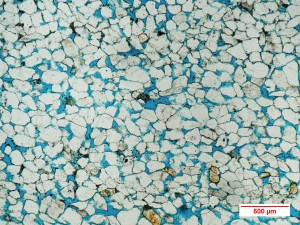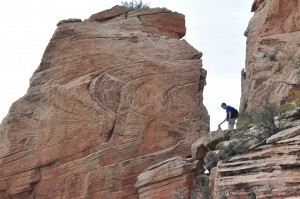Recently, two new papers on the Coconino Sandstone were published by the Answers Research Journal. John Whitmore, Ray Strom, Paul Garner, Guy Forsythe, Stephen Cheung and some others have been working on the Coconino for about the past ten years. The Coconino is a cross-bedded sandstone that outcrops prominently in areas like the Grand Canyon and Sedona, Arizona. Many believe that the sandstone represents remnants of desert sand dunes deposited during the Permian Period. Our research in these two papers demonstrates that there is abundant evidence for the subaqueous origin of the Coconino. These papers represent the first comprehensive research on this sandstone since the eminent Grand Canyon geologist Edwin McKee published a monograph on it in 1934. He concluded the sandstone likely represented desert dunes; and few have questioned his interpretation since then.
The first paper deals with the petrology, or the microscopic examination of the sandstone. This paper contains the first thin section photos of the Coconino that have ever been published. Most have argued the Coconino has well-rounded and well-sorted sand grains; but our photographs and measurements show this is clearly not true. Additionally, almost all of the thin sections studied in detail (>100), we found very thin and soft mica flakes. They are common in water-deposited sandstones, but almost absent in deserts because micas are easily abraded by grain to grain collisions that happen when sand grains are carried across a sand dune by wind. This does not happen when mica is transported by water. We also found the mineral dolomite at a number of locations, including dolomite ooids, which are small sand-sized pellets that typically form in shallow marine settings. This is one of the first reports of dolomite ooids in the literature.
Our second paper deals with some large parabolic recumbent folds in the Coconino that were discovered by Guy Forsythe in the Sedona area. These types of folds only form as cross-beds are overturned under strong, unidirectional water currents. Some may argue the folds represent slumps of large sand dunes, however the folds deform in the direction of cross-bed dip and can be followed for many 10’s of meters along the face of the outcrop; so slumping eolian dunes cannot explain the deformation.
Based on our research, we believe the Coconino represents large subaqueous sand wave deposits. Sand waves are large underwater sand dunes that in many ways resemble desert sand dunes. They form underwater by strong water currents and can commonly be found on the continental shelves of today’s ocean floors. Some of the more famous sand waves occur in San Francisco Bay and Long Island Sound, but many more locations have been documented around the world.
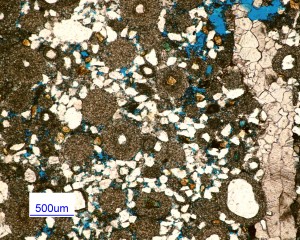
Dolomite ooids in cross-bedded Coconino, Andrus Point. It is thought that these can only form in a marine setting.
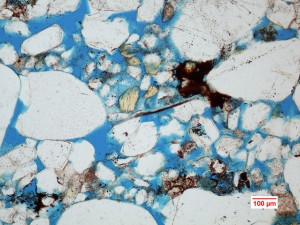
Large flake of mica (center) in Coconino from Warm Springs Canyon. Mica quickly disappears in desert settings because it is so soft. Also notice the very poor sorting in this sample.
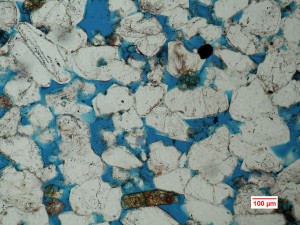
Coconino Sandstone from New Hance Trail, Grand Canyon. Notice the subangular to subrounded nature of the sand grains.
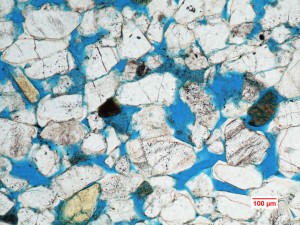
Coconino Sandstone from near Chino Valley, Arizona. Notice how angular the softer K-feldspar is (yellow) compared the the harder quartz grains (white).
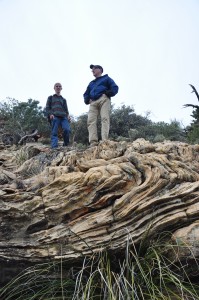
A Cedarville geology major and the university photographer standing on a large parabolic recumbent fold in Sedona, Arizona.
Posted in: Uncategorized

















